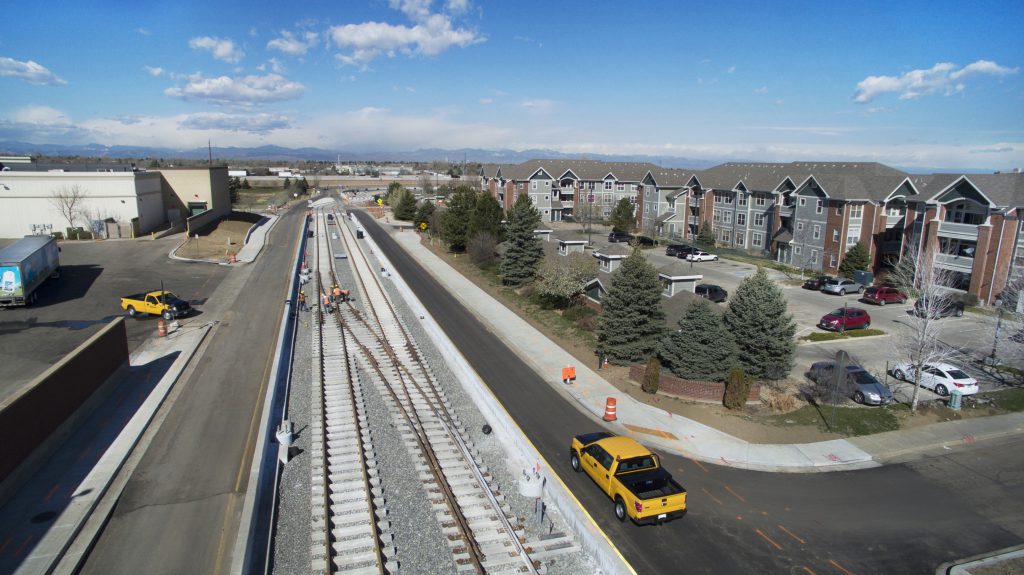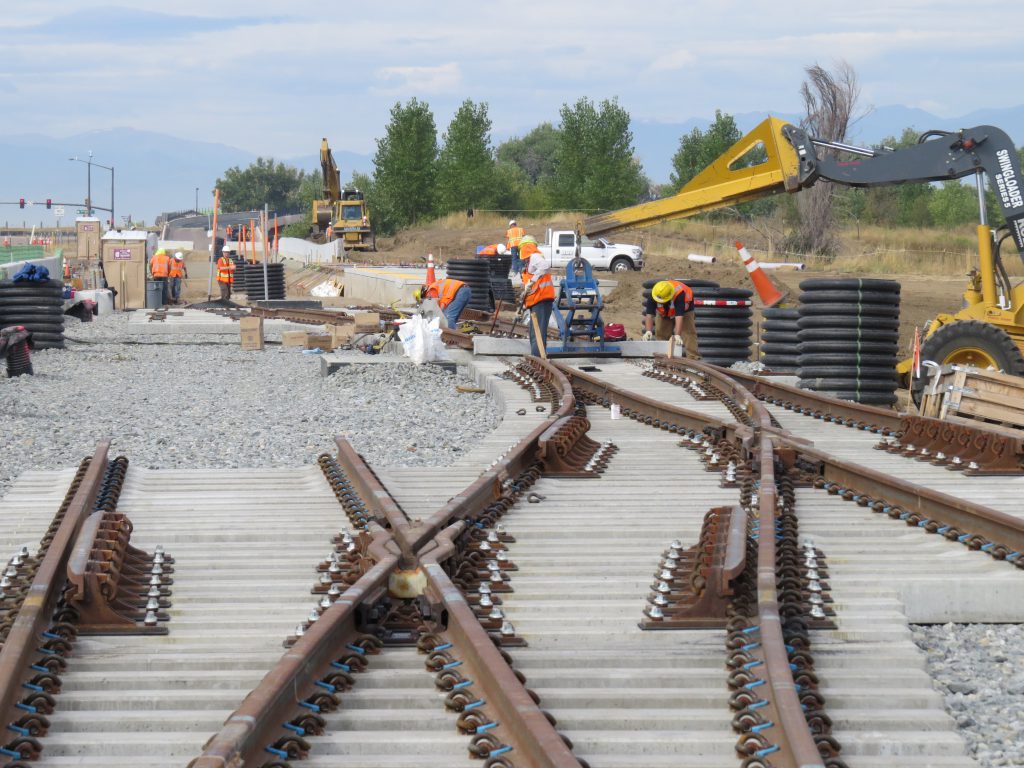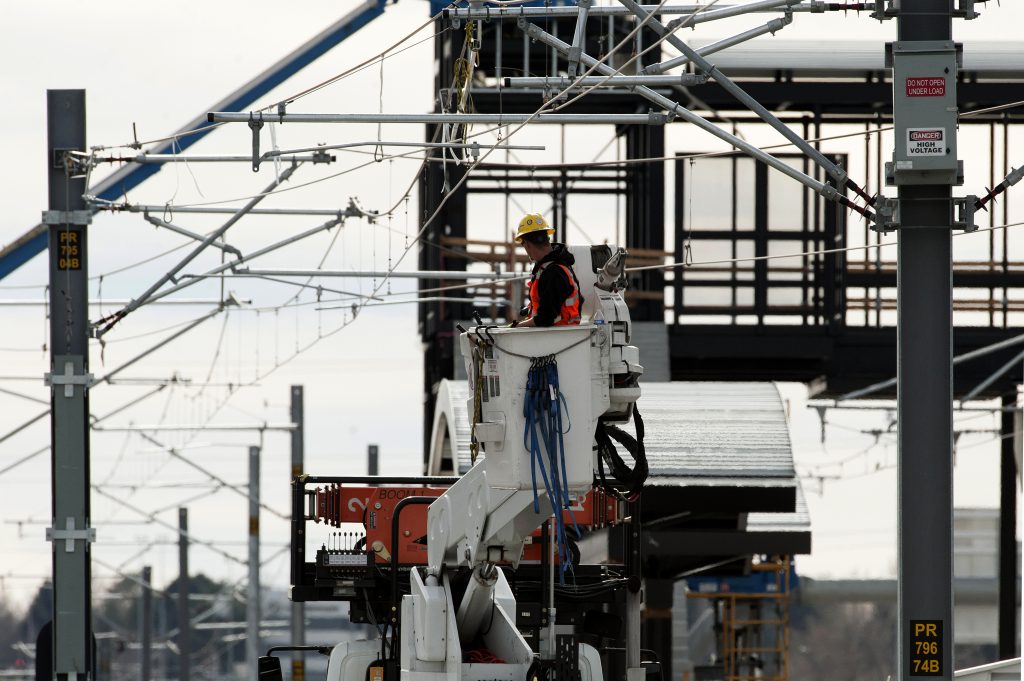Aurora’s R Line set to debut
You could say Aurora, Colorado, leads a double life.
It’s one of the original streetcar suburbs of Denver, with roots dating to 1891 when the town was called “Fletcher” and encompassed just four square miles of prairie. Today, Aurora is a thriving part of the Denver metropolitan area.
It’s also a metropolis in its own right, with the third-largest population in the state and a ranking as the 54th most populous city in the United States according to the U.S. Census Bureau. It’s home to more than 350,000 people who call it a place to live, work and play.
When it comes to getting around in Aurora, finding the right balance between being an independent town and a Denver suburb is important to city leaders. Residents need to have access to destinations close to home yet still feel connected to the larger metro area and beyond.
A new transportation project is helping Aurora do just that, thanks to the expansion of the area’s light-rail system along the north-south Interstate 225 corridor.
10.5 miles and 8 new stations
The $440 million project is being led by Kiewit Infrastructure Co. By the end of this year, the I-225 project — designated by the Regional Transportation District (RTD) as the R Line — will add 10.5 miles to the RTD’s planned 122-mile commuter rail and light rail expansion.
“The project is coming full circle with our previous work in the Denver metro,” said Pete Remington, Kiewit deputy project manager.
The R Line will connect with Nine Mile Station, which was part of Kiewit’s contract on the Transportation Expansion Project, or T-REX, completed in 2006. As part of that project, the T-REX team built 19 miles of light rail line and 13 new stations, including Nine Mile.
The I-225 project is part of FasTracks, a transportation initiative aimed to make getting around easy and convenient for travelers in the eight-county Denver area. In 2016 alone, FasTracks will roll out 50.5 miles of new rail lines, including the R Line, as well as 18 miles of bus transit.
“The R Line is one of those last links that connects those two areas,” Remington said. “It allows anybody to get to the airport or go downtown on the commuter rail.”
Eight new stations — making for a total of 16 — will also add convenient access for commuters to the Aurora Town Center, University of Colorado Denver Anchutz Medical Campus, the new VA hospital and Denver Tech Center.
A game changer for Aurora
In the area surrounding the project, where a large number of residents rely on public transit to get around, RTD’s light rail system provides a crucial service. In fact, compared with other areas in the FasTracks region, this area has the highest need for public transportation.
Especially important to Aurora commuters and the businesses that serve them is that the R Line will travel through the heart of the city.
“This is really the first rail line that will provide connectivity to that city as part of the metro region,” Kiewit Project Engineer Michael Massman said. “This is a big deal to the local municipality. The line will bring people into the city center.”
RTD Construction Manager Chris Hinton agreed. “This is really a game changer for Aurora. It gives the city the chance to be recognized and connected to the rest of the community as a major urban center.”
That dovetails well with an urban-renewal project underway that’s designed to bring new and refurbished retail, real estate, administrative offices and street improvements to downtown Aurora.
Bringing completion back online
In addition to the traditional design-build aspects of this project, Kiewit also created a not-so-typical solution to a budgetary concern.
When the recession caused tax revenue to decrease and construction costs to spike, the owner needed to consider pushing off significant portions of the entire FasTracks project — including sections of the R Line — until 2042.
“We submitted an unsolicited proposal that included a banking partner to provide a financial solution,” said Massman. “It was structured in a way that allowed the owner to work within its existing debt constraints.”
That solution made the difference between pushing completion of the entire R Line from years down the line, to bringing it online at the end of 2016. RTD ultimately entered into a separate funding agreement with the bank from Kiewit’s proposal.
Crews place ties along Fitzsimons Parkway. The Fitzsimons stations will service patients and employees of the Fitzsimons Medical Campus, CU Anschutz Medical Center and the U.S. Department of Veterans Affairs Eastern Colorado Medical Centers.
Taking changes in stride
The project has also posed physical changes that have challenged the team, says Remington.
Originally, the line was designed to run through a multi-hospital medical campus. Because of concerns about electricity and vibration from the light rail train interfering with sensitive research equipment used in the facilities, the plan was changed to realign the route.
This, as well as two other major alignment shifts, set in motion a domino effect that impacted the right-of-way acquisition and related intersections, not to mention the location of utilities on the route.
While those changes don’t appear to be large on paper, especially when things are only moving a few hundred feet, it meant starting the process again from scratch in many cases.
Kiewit took the challenges in stride.
“Our team was flexible and worked with the client to mitigate the extent of these impacts,” Massman said.
“We’re never satisfied and we always make sure to align with RTD’s goals,” added Remington. “I think our ability to make sure we meet the client’s expectations has allowed us to go ahead and keep the project on schedule.”
Hinton remembers the alignment change as a “make-it-or-break-it” event that he said “could have easily killed the project. The willingness of the Kiewit team to adapt and work with RTD on a solution saved it.”
As the project moves into the home stretch, the Kiewit and RTD teams are looking forward to taking their inaugural ride.
For the Aurora commuters poised to step on the light rail platforms for the first time, the opening of the R Line will be a big leap into a well-connected future. And for a town once known as a streetcar suburb, that’s an important step in defining how much Aurora has grown into a significant Colorado hub.







